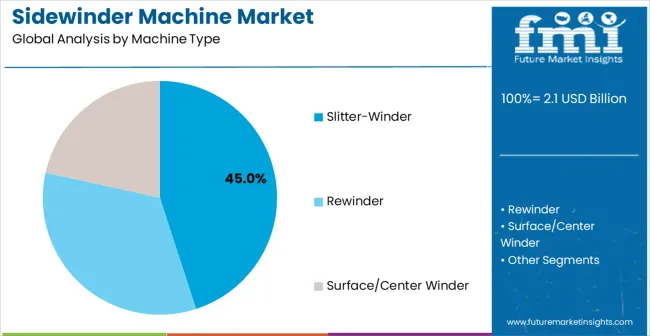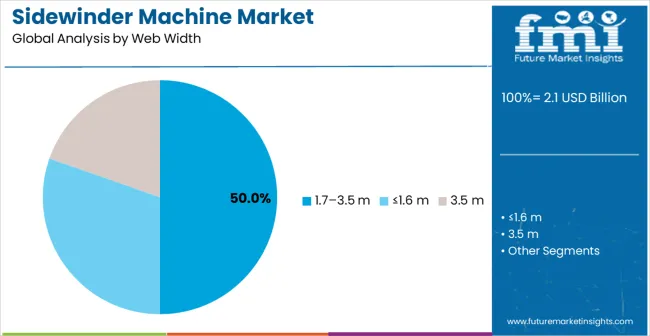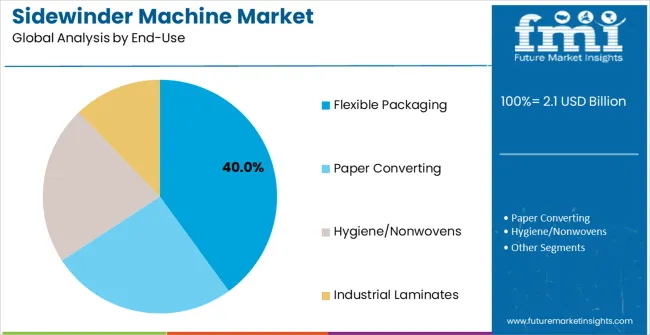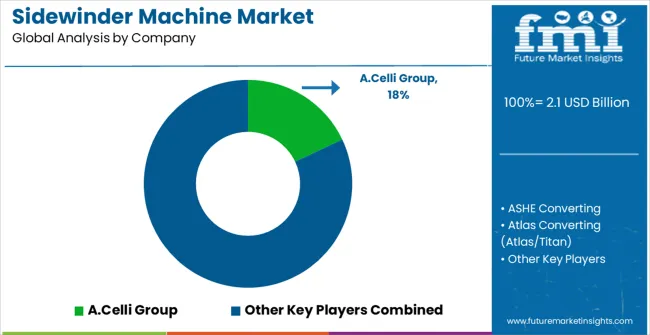The sidewinder machine market is estimated to be valued at USD 2.1 billion in 2025 and is projected to reach USD 2.9 billion by 2035, registering a compound annual growth rate (CAGR) of 3.4% over the forecast period.
| Metric | Value |
|---|---|
| Sidewinder Machine Market Estimated Value in (2025 E) | USD 2.1 billion |
| Sidewinder Machine Market Forecast Value in (2035 F) | USD 2.9 billion |
| Forecast CAGR (2025 to 2035) | 3.4% |
The sidewinder machine market represents a stable industrial opportunity at the intersection of converting automation, precision engineering, and machine technology, with the market projected to expand from USD 2.1 billion in 2025 to USD 2.9 billion by 2035 at a steady 3.4% CAGR-a 1.4X growth driven by increasing converting precision requirements, industrial automation adoption, and the integration of advanced machine control systems into production processes.
This convergence opportunity leverages the necessity of converting precision, the demand for consistent winding quality, and advances in machine technology to create equipment that offers reliable performance in critical converting applications. The slitter-winder machine type segment leads with 45% market share due to its optimal balance of functionality and versatility for most industrial applications, while 1.7–3.5 m web width configurations dominate with 50% share as the preferred setup for precision work. Geographic growth is strongest in China (5.1% CAGR) and Brazil (4.6% CAGR), where expanding manufacturing sectors and infrastructure development create ideal market conditions.
Pathway A - Slitter-Winder Machine Type Leadership. The dominant machine segment offers an optimal balance between performance and versatility essential for precision converting operations. Companies developing advanced slitter-winder systems with enhanced control capabilities, variable speed functions, and automation features will capture the leading technology segment. Expected revenue pool: USD 1.0-1.3 billion.
Pathway B - 1.7-3.5 m Web Width Integration. The largest web width segment benefits from widespread adoption in medium-scale converting and manufacturing applications. Providers developing comprehensive mid-width solutions with advanced tension control, precise winding systems, and operational features will dominate this primary market. Opportunity: USD 1.2-1.5 billion.
Pathway C - Flexible Packaging End-Use Applications. The largest application segment requires specialized machine characteristics for demanding packaging operations. Companies investing in application-specific machine designs, enhanced precision features, and integration capabilities will create competitive differentiation and premium positioning. Revenue uplift: USD 0.8-1.2 billion.
Pathway D - Geographic Expansion in High-Growth Markets. China and Brazil's expanding manufacturing sectors and growing industrial automation adoption create substantial opportunities. Local partnerships, culturally adapted service models, and competitive pricing strategies enable market penetration in these high-growth regions. Pool: USD 0.5-0.8 billion.
Pathway E - Energy Efficiency and Smart Machine Technologies. Modern manufacturers prioritize energy conservation and operational intelligence. Developing machines with smart controls, predictive maintenance capabilities, variable frequency drives, and integration with Industry 4.0 systems addresses growing efficiency demands while reducing operational costs. Expected upside: USD 0.4-0.7 billion.
Pathway F - Advanced Machine Control and Automation Integration. Premium applications require sophisticated speed control, tension management, and integration with automated converting systems. Machines offering comprehensive connectivity options, precise control algorithms, and compatibility with manufacturing execution systems create enhanced value propositions. USD 0.5-0.8 billion.
Pathway G - Specialized Application Development. Paper converting, hygiene/nonwovens, and industrial laminates represent growing opportunities for specialized machine configurations optimized for specific converting requirements. Developing application-specific solutions with tailored performance characteristics expands beyond general industrial markets. Pool: USD 0.3-0.6 billion.
Pathway H - Premium Performance and Durability Features. High-end converting segments demand advanced features like extended service life, precision speed control, minimal vibration, and premium build quality. Companies developing industrial-grade variants with comprehensive performance features will capture premium pricing opportunities. Expected revenue: USD 0.4-0.6 billion.
/
Why is the Sidewinder Machine Market Growing?
Market expansion is being supported by the increasing global demand for converting automation solutions and the corresponding shift toward advanced machine technologies that can provide superior precision control while meeting industry requirements for consistent and reliable winding operations. Modern converting facilities and manufacturing shops are increasingly focused on incorporating high-performance sidewinder machines to enhance production quality while satisfying demands for precision converting capabilities and automated production systems. Sidewinder machines' proven ability to deliver superior consistency, operational reliability, and process control makes them essential equipment for advanced converting installations and industrial manufacturing applications.
The growing emphasis on converting precision and industrial automation is driving demand for high-quality sidewinder machine products that can support distinctive converting processes and premium production positioning across flexible packaging, paper converting, and hygiene/nonwoven categories. Industrial equipment preference for machines that combine performance excellence with advanced control capabilities is creating opportunities for innovative machine implementations in both traditional and emerging converting applications. The rising influence of Industry 4.0 technologies and connected manufacturing systems is also contributing to increased adoption of premium sidewinder machine products that can provide authentic smart manufacturing integration characteristics.
The sidewinder machine market is segmented by machine type, web width, end-use, and geographic regions. By machine type, sidewinder machine market is divided into Slitter-Winder, Rewinder, and Surface/Center Winder. In terms of web width, sidewinder machine market is classified into 1.7–3.5 m, ≤1.6 m, and 3.5 m. Based on end-use, sidewinder machine market is segmented into Flexible Packaging, Paper Converting, Hygiene/Nonwovens, and Industrial Laminates. Regionally, the sidewinder machine industry is classified into North America, Latin America, Western Europe, Eastern Europe, Balkan & Baltic Countries, Russia & Belarus, Central Asia, East Asia, South Asia & Pacific, and the Middle East & Africa.
The market is segmented by machine type, web width, end-use sector, and region. The demand for machine types is divided into slitter-winder, rewinder, surface/center winder, and others. Based on web width, the market is categorized into ≤1.6 m, 1.7–3.5 m, and>3.5 m applications. The end-use sector is segmented into flexible packaging, paper converting, hygiene/nonwovens, and industrial laminates. Regionally, the market is divided into North America, Europe, Asia Pacific, Latin America, and the Middle East & Africa.

The slitter-winder machine type segment is projected to account for 45% of the sidewinder machine market in 2025, reaffirming its position as the leading machine category. Industrial equipment manufacturers and converting facilities increasingly utilize slitter-winder systems for their optimal balance of cutting and winding capabilities, operational efficiency, and versatility in converting applications across diverse industrial installations. This machine type's standardized performance characteristics and reliable operation directly address the industrial requirements for consistent quality control and efficient material processing in precision converting operations.
This machine type segment forms the foundation of modern industrial converting applications, as it represents the machine category with the greatest potential for versatility and established compatibility across multiple web width configurations and end-use applications. Manufacturer investments in machine optimization and control system integration continue to strengthen adoption among industrial equipment producers. With manufacturers prioritizing operational efficiency and consistent performance, slitter-winder systems align with both productivity objectives and quality assurance requirements, making them the central component of comprehensive industrial converting strategies.

1.7-3.5 m web width applications are projected to represent the largest share of sidewinder machine demand in 2025, with 50% market share, underscoring their critical role as the primary configuration for medium-scale converting operations in manufacturing and processing environments. Equipment manufacturers and industrial facilities prefer 1.7-3.5 m systems for their exceptional operational characteristics, versatile handling capabilities, and ability to maintain consistent processing positions while supporting advanced converting requirements during precision manufacturing operations. Positioned as essential equipment for high-performance industrial installations, 1.7-3.5 m sidewinder machines offer both operational reliability and production optimization advantages.
The segment is supported by continuous growth in medium-scale converting adoption and the growing availability of advanced 1.7-3.5 m systems that enable enhanced operational control and quality optimization at the industrial level. Additionally, manufacturers are investing in premium medium-width configurations to support production quality enhancement and operational efficiency experiences. As medium-scale converting continues to expand and facilities seek superior control solutions, 1.7-3.5 m web width applications will continue to dominate the configuration landscape while supporting technology advancement and operational optimization strategies.

Flexible packaging end-use applications are projected to represent the largest share of sidewinder machine demand in 2025, with 40% market share, underscoring their critical role as the primary sector for precision converting operations in packaging manufacturing and processing environments. Equipment manufacturers and packaging facilities prefer flexible packaging applications for their exceptional quality characteristics, precise control capabilities, and ability to maintain consistent packaging standards while supporting advanced converting requirements during precision manufacturing operations. Positioned as essential equipment for high-performance packaging installations, flexible packaging sidewinder machines offer both operational reliability and quality assurance advantages.
The segment is supported by continuous growth in flexible packaging adoption and the growing availability of advanced packaging converting systems that enable enhanced operational control and quality optimization at the packaging facility level. Additionally, manufacturers are investing in premium packaging configurations to support production quality enhancement and market competitiveness. As flexible packaging continues to expand and facilities seek superior control solutions, flexible packaging applications will continue to dominate the end-use landscape while supporting technology advancement and operational optimization strategies.
The sidewinder machine market is advancing steadily due to increasing converting automation adoption and growing demand for precision machine solutions that emphasize superior operational control across packaging, paper, and nonwoven converting applications. However, the market faces challenges, including high equipment costs compared to manual alternatives, technical complexity in machine control integration, and competition from alternative converting technologies. Innovation in machine efficiency and smart control systems continues to influence market development and expansion patterns.
The growing adoption of sidewinder machines in comprehensive converting operations and automated production applications is enabling equipment manufacturers to develop products that provide distinctive precision capabilities while commanding premium positioning and enhanced operational characteristics. Advanced applications provide superior control while allowing more sophisticated converting development across various industrial categories and technology segments. Manufacturers are increasingly recognizing the competitive advantages of automation positioning for premium product development and industrial market penetration.
Modern sidewinder machine suppliers are incorporating advanced energy management systems, smart control technologies, and usage optimization algorithms to enhance operational efficiency, improve energy conservation, and meet industrial demands for sustainable and cost-effective converting solutions. These programs improve equipment performance while enabling new applications, including energy-smart manufacturing and automated quality management systems. Advanced efficiency integration also allows suppliers to support premium market positioning and sustainability leadership beyond traditional commodity industrial converting equipment products.
| Country | CAGR (2025-2035) |
|---|---|
| China | 5.1% |
| Brazil | 4.6% |
| France | 3.4% |
| USA | 3.2% |
| UK | 3.0% |
The sidewinder machine market is experiencing varied growth globally, with China leading at a 5.1% CAGR through 2035, driven by the rapidly expanding manufacturing sector, substantial investments in converting infrastructure, and increasing adoption of automated production systems. Brazil follows at 4.6%, supported by growing industrial development, rising manufacturing investments, and expanding precision converting activities. France shows growth at 3.4%, emphasizing advanced converting technology and premium industrial equipment development. The USA records 3.2%, focusing on precision engineering applications and industrial automation advancement. The UK demonstrates 3.0% growth, prioritizing the conversion of innovation and industrial equipment modernization.
The report covers an in-depth analysis of 40+ countries; five top-performing countries are highlighted below.
Revenue from sidewinder machines in China is projected to exhibit exceptional growth with a CAGR of 5.1% through 2035, driven by the rapidly expanding manufacturing sector and substantial government investments in industrial diversification programs across major industrial centers. The country's growing industrial base and increasing adoption of automated converting technologies are creating significant demand for precision sidewinder equipment in both heavy industrial and specialized converting applications. Major industrial equipment manufacturers and machine companies are establishing comprehensive distribution and service capabilities to serve both domestic consumption and regional export markets.
Revenue from sidewinder machines in Brazil is expanding at a CAGR of 4.6%, supported by growing industrial development, increasing converting investments, and expanding precision manufacturing capabilities with modern automation features. The country's developing converting ecosystem and expanding industrial infrastructure are driving demand for reliable sidewinder machine products across both traditional converting and emerging precision manufacturing applications. International equipment companies and domestic machine manufacturers are establishing comprehensive production and distribution capabilities to address growing market demand for industrial converting solutions.
Revenue from sidewinder machines in France is projected to grow at a CAGR of 3.4% through 2035, driven by the country's advanced converting technology sector, premium industrial equipment development capabilities, and leadership in precision converting solutions. France's sophisticated manufacturing culture and willingness to invest in high-performance industrial equipment are creating substantial demand for both standard and premium sidewinder machine varieties. Leading equipment companies and machine manufacturers are establishing comprehensive innovation strategies to serve both European markets and growing international demand.
Revenue from sidewinder machines in the USA is projected to grow at a CAGR of 3.2% through 2035, supported by the country's precision engineering excellence, advanced converting sector, and leadership in industrial automation technologies requiring sophisticated machine solutions. American manufacturers and industrial facility operators consistently seek innovative equipment products that enhance operational precision for both traditional converting applications and advanced industrial markets. The country's position as a converting technology hub continues to drive innovation in industrial automation applications and equipment standards.
Revenue from sidewinder machines in the UK is projected to grow at a CAGR of 3.0% through 2035, supported by the country's advanced converting sector, innovation leadership capabilities, and established market for premium industrial equipment solutions. British manufacturers and industrial facility operators prioritize innovation, reliability, and technical excellence, making sidewinder machines essential equipment for both converting modernization and new facility projects. The country's comprehensive industrial ecosystem and adoption patterns support continued market development.
The sidewinder machine market in Europe is projected to grow from USD 0.5 billion in 2025 to USD 0.7 billion by 2035, registering a CAGR of 3.2% over the forecast period. Germany is expected to maintain its leadership position with a 35.2% market share in 2025, remaining stable at 35.0% by 2035, supported by its advanced precision engineering sector, premium industrial equipment manufacturing industry, and comprehensive innovation capabilities serving European and international markets.
France follows with a 22.8% share in 2025, projected to reach 23.1% by 2035, driven by advanced converting technology adoption programs, precision engineering development capabilities, and growing focus on industrial automation solutions for premium converting facilities. The United Kingdom holds an 18.4% share in 2025, expected to maintain 18.2% by 2035, supported by converting innovation market demand and advanced technology applications, but facing challenges from market competition and economic considerations. Italy commands a 12.6% share in 2025, projected to reach 12.8% by 2035, while Spain accounts for 7.3% in 2025, expected to reach 7.5% by 2035. The Netherlands maintains a 3.7% share in 2025, growing to 3.8% by 2035. The Rest of Europe region, including Nordic countries, Eastern Europe, Belgium, Switzerland, and Austria, is anticipated to hold 18.6% in 2025, declining slightly to 18.4% by 2035, attributed to mixed growth patterns with strong expansion in some Nordic converting markets balanced by moderate growth in smaller countries implementing industrial modernization programs.

The sidewinder machine market is characterized by competition among established industrial converting equipment manufacturers, specialized machine companies, and integrated automation solution providers. Companies are investing in advanced machine control technologies, energy efficiency optimization systems, application-specific product development, and comprehensive performance enhancement capabilities to deliver consistent, high-performance, and reliable sidewinder machine products. Innovation in efficiency enhancement, tension control optimization, and customized industrial compatibility is central to strengthening market position and customer satisfaction.
A.Celli Group leads the market with a strong focus on industrial converting innovation and comprehensive automation solutions, offering advanced sidewinder machine products that emphasize reliability and technology integration excellence. ASHE Converting provides specialized industrial converting capabilities with a focus on quality manufacturing and market leadership. Atlas Converting (Atlas/Titan) delivers comprehensive converting solutions with a focus on industrial applications and operational reliability. CATBRIDGE Machinery specializes in converting equipment with an emphasis on precision and user-friendly design. EUROMAC focuses on advanced converting technologies and distribution networks. Elite Cameron emphasizes industrial automation expertise with a focus on system integration and operational efficiency.
| Items | Values |
|---|---|
| Quantitative Units (2025) | USD 2.1 Billion |
| Machine Type | Slitter-Winder, Rewinder, Surface/Center Winder, Others |
| Web Width | ≤1.6 m, 1.7–3.5 m, >3.5 m |
| End-Use Sector | Flexible Packaging, Paper Converting, Hygiene/Nonwovens, Industrial Laminates |
| Regions Covered | North America, Europe, Asia Pacific, Latin America, Middle East & Africa |
| Countries Covered | United States, Canada, United Kingdom, Germany, France, China, Japan, South Korea, India, Brazil, Australia and 40+ countries |
| Key Companies Profiled | A.Celli Group, ASHE Converting, Atlas Converting (Atlas/Titan), CATBRIDGE Machinery, EUROMAC, Elite Cameron, GOEBEL IMS, Kampf Schneid- und Wickeltechnik, Laem System, and Parkinson Technologies (Dusenbery) |
| Additional Attributes | Dollar sales by machine type and web width, regional demand trends, competitive landscape, technological advancements in machine control systems, industrial automation integration initiatives, energy efficiency optimization programs, and operational performance enhancement strategies |
The global sidewinder machine market is estimated to be valued at USD 2.1 billion in 2025.
The market size for the sidewinder machine market is projected to reach USD 2.9 billion by 2035.
The sidewinder machine market is expected to grow at a 3.4% CAGR between 2025 and 2035.
The key product types in sidewinder machine market are slitter-winder, rewinder and surface/center winder.
In terms of web width, 1.7–3.5 m segment to command 50.0% share in the sidewinder machine market in 2025.






Our Research Products

The "Full Research Suite" delivers actionable market intel, deep dives on markets or technologies, so clients act faster, cut risk, and unlock growth.

The Leaderboard benchmarks and ranks top vendors, classifying them as Established Leaders, Leading Challengers, or Disruptors & Challengers.

Locates where complements amplify value and substitutes erode it, forecasting net impact by horizon

We deliver granular, decision-grade intel: market sizing, 5-year forecasts, pricing, adoption, usage, revenue, and operational KPIs—plus competitor tracking, regulation, and value chains—across 60 countries broadly.

Spot the shifts before they hit your P&L. We track inflection points, adoption curves, pricing moves, and ecosystem plays to show where demand is heading, why it is changing, and what to do next across high-growth markets and disruptive tech

Real-time reads of user behavior. We track shifting priorities, perceptions of today’s and next-gen services, and provider experience, then pace how fast tech moves from trial to adoption, blending buyer, consumer, and channel inputs with social signals (#WhySwitch, #UX).

Partner with our analyst team to build a custom report designed around your business priorities. From analysing market trends to assessing competitors or crafting bespoke datasets, we tailor insights to your needs.
Supplier Intelligence
Discovery & Profiling
Capacity & Footprint
Performance & Risk
Compliance & Governance
Commercial Readiness
Who Supplies Whom
Scorecards & Shortlists
Playbooks & Docs
Category Intelligence
Definition & Scope
Demand & Use Cases
Cost Drivers
Market Structure
Supply Chain Map
Trade & Policy
Operating Norms
Deliverables
Buyer Intelligence
Account Basics
Spend & Scope
Procurement Model
Vendor Requirements
Terms & Policies
Entry Strategy
Pain Points & Triggers
Outputs
Pricing Analysis
Benchmarks
Trends
Should-Cost
Indexation
Landed Cost
Commercial Terms
Deliverables
Brand Analysis
Positioning & Value Prop
Share & Presence
Customer Evidence
Go-to-Market
Digital & Reputation
Compliance & Trust
KPIs & Gaps
Outputs
Full Research Suite comprises of:
Market outlook & trends analysis
Interviews & case studies
Strategic recommendations
Vendor profiles & capabilities analysis
5-year forecasts
8 regions and 60+ country-level data splits
Market segment data splits
12 months of continuous data updates
DELIVERED AS:
PDF EXCEL ONLINE
Machine Glazed Paper Market Size and Share Forecast Outlook 2025 to 2035
Machine Glazed Kraft Paper Market Forecast and Outlook 2025 to 2035
Machine Condition Monitoring Market Size and Share Forecast Outlook 2025 to 2035
Machine Glazed Paper Industry Analysis in Asia Pacific Forecast Outlook 2025 to 2035
Machine Vision Camera Market Size and Share Forecast Outlook 2025 to 2035
Machine Tool Oils Market Size and Share Forecast Outlook 2025 to 2035
Machine Vision System And Services Market Size and Share Forecast Outlook 2025 to 2035
Machine Glazed Paper Industry Analysis in Western Europe Size and Share Forecast Outlook 2025 to 2035
Machine Glazed Paper Industry Analysis in Korea Size and Share Forecast Outlook 2025 to 2035
Machine Glazed Paper Industry Analysis in Japan Size and Share Forecast Outlook 2025 to 2035
Machine Tool Cooling System Market Analysis - Size, Share, and Forecast Outlook 2025 to 2035
Machine Tool Touch Probe Market Analysis - Size, Growth, and Forecast 2025 to 2035
Machine Mount Market Analysis - Size & Industry Trends 2025 to 2035
Machine Control System Market Growth – Trends & Forecast 2025 to 2035
Machine Automation Controller Market Growth – Trends & Forecast 2025 to 2035
Machine-to-Machine (M2M) Connections Market – IoT & Smart Devices 2025 to 2035
Machine Safety Market Analysis by Component, Industry, and Region Through 2035
Key Players & Market Share in Machine Glazed Paper Industry
Machine Vision Market Insights – Growth & Forecast 2024-2034
Machine Learning As A Services Market

Thank you!
You will receive an email from our Business Development Manager. Please be sure to check your SPAM/JUNK folder too.
Chat With
MaRIA